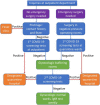Resumption of the treatment of non-COVID-19 gynecologic patients after lifting lockdown: Triage and infection prevention experiences from Wuhan
- PMID: 34322966
- PMCID: PMC8457066
- DOI: 10.1111/jog.14917
Resumption of the treatment of non-COVID-19 gynecologic patients after lifting lockdown: Triage and infection prevention experiences from Wuhan
Abstract
Aim: To share our experiences of resuming the treatments for gynecologic patients after lifting the lockdown in a hotspot area for the Coronavirus Disease 2019 (COVID-19) pandemic.
Methods: The triage process used to resume medical activities for gynecologic patients at the Wuhan Union Hospital after a 76-day lockdown of the city is described, and its effectiveness in preventing COVID-19 nosocomial transmission is shown.
Results: Nonemergency patients were pretriaged based on their contact history and body temperature at an outpatient clinic, and negative COVID-19 screening test results were required for admission to the buffering rooms at the gynecologic department. The buffering lasted at least 3 days for symptom monitoring, and a second round of COVID-19 testing was required before patients could be transferred to the regular gynecologic wards. For patients who needed emergency surgery, the first screening was completed at the isolation wards after surgery, followed by buffering at the gynecologic department. We received 19 298 outpatient visits, admitted 326 patients, and performed 223 operations in the first 2 months after the lockdown was lifted. No COVID-19 cases occurred in the hospitalized patients, while the proportion of potentially high-risk patients with cancer and severe anemia was increased in comparison to that observed during the same period in 2019 and the first 2 months of 2020 before the lockdown.
Conclusions: We provide an effective triage system with buffering at two levels to guarantee safe and timely treatment for non-COVID-19 gynecologic patients in the postlockdown phase.
Keywords: buffering room; gynecologic surgery; pandemic; personal protective equipment; triage strategy.
© 2021 The Authors. Journal of Obstetrics and Gynaecology Research published by John Wiley & Sons Australia, Ltd on behalf of Japan Society of Obstetrics and Gynecology.
Conflict of interest statement
The authors declared no potential conflicts of interest.
Figures
Similar articles
-
Could masks curtail the post-lockdown resurgence of COVID-19 in the US?Math Biosci. 2020 Nov;329:108452. doi: 10.1016/j.mbs.2020.108452. Epub 2020 Aug 18. Math Biosci. 2020. PMID: 32818515 Free PMC article.
-
Spring in London with Covid-19: a personal view.Med Leg J. 2020 Jul;88(2):57-64. doi: 10.1177/0025817220923692. Epub 2020 Jun 9. Med Leg J. 2020. PMID: 32515258
-
Our experiences of resuming services in ENT departments in Wuhan, once a COVID-19 epicenter.Am J Otolaryngol. 2020 Nov-Dec;41(6):102678. doi: 10.1016/j.amjoto.2020.102678. Epub 2020 Aug 13. Am J Otolaryngol. 2020. PMID: 32846406 Free PMC article.
-
Approaches to the management of patients in oral and maxillofacial surgery during COVID-19 pandemic.J Craniomaxillofac Surg. 2020 May;48(5):521-526. doi: 10.1016/j.jcms.2020.03.011. Epub 2020 Apr 4. J Craniomaxillofac Surg. 2020. PMID: 32303420 Free PMC article. Review.
-
Perioperative Considerations in Urgent Surgical Care of Suspected and Confirmed COVID-19 Orthopaedic Patients: Operating Room Protocols and Recommendations in the Current COVID-19 Pandemic.J Am Acad Orthop Surg. 2020 Jun 1;28(11):451-463. doi: 10.5435/JAAOS-D-20-00227. J Am Acad Orthop Surg. 2020. PMID: 32282441 Free PMC article. Review.
Cited by
-
The Effectiveness of Pap and Visual Inspection With Acetic Acid (VIAA) Tests in Cervical Dysplasia Screenings During the COVID-19 Pandemic.Cureus. 2022 Jul 27;14(7):e27364. doi: 10.7759/cureus.27364. eCollection 2022 Jul. Cureus. 2022. PMID: 36046272 Free PMC article.
References
-
- Komatsu H, Banno K, Yanaihara N, Kimura T, Board Members of Japan Society of Obstetrics and Gynecology . Prevention and practice during the COVID‐19 emergency declaration period in Japanese obstetrical/gynecological facilities. J Obstet Gynaecol Res. 2020;46(11):2237–41. 10.1111/jog.14432 - DOI - PubMed
MeSH terms
LinkOut - more resources
Full Text Sources
Medical


